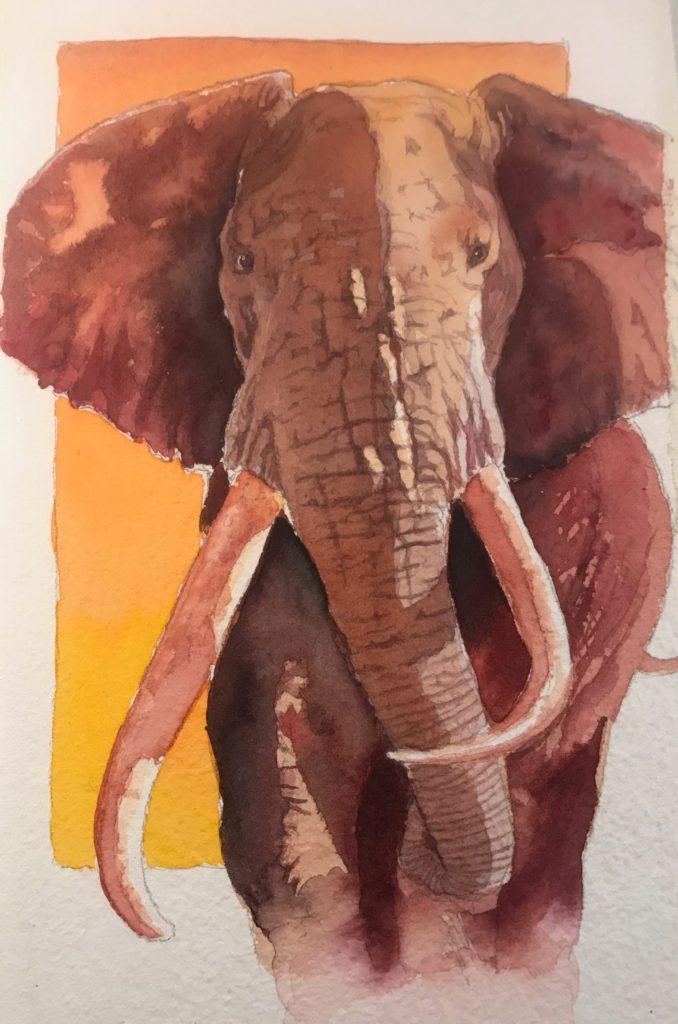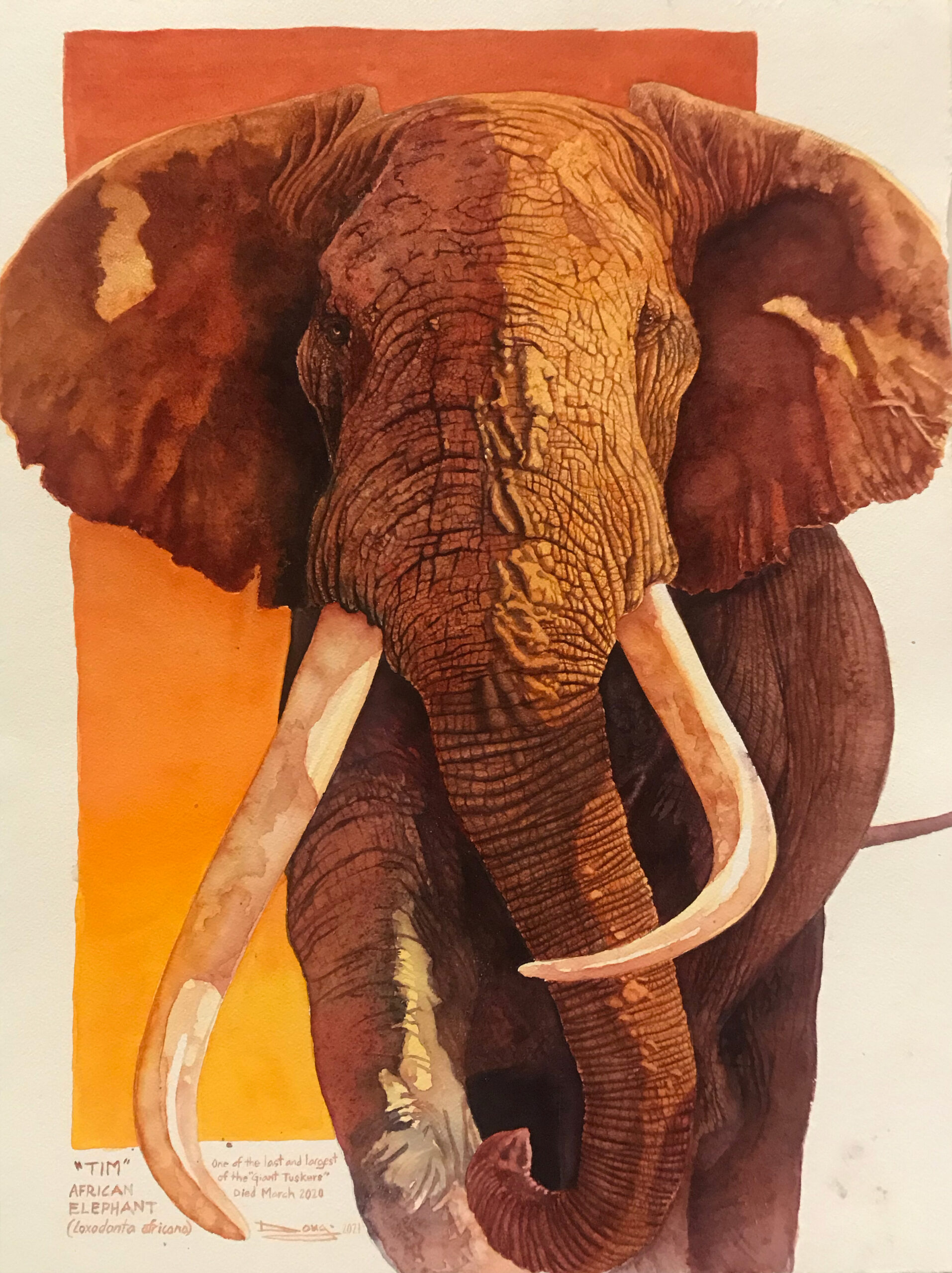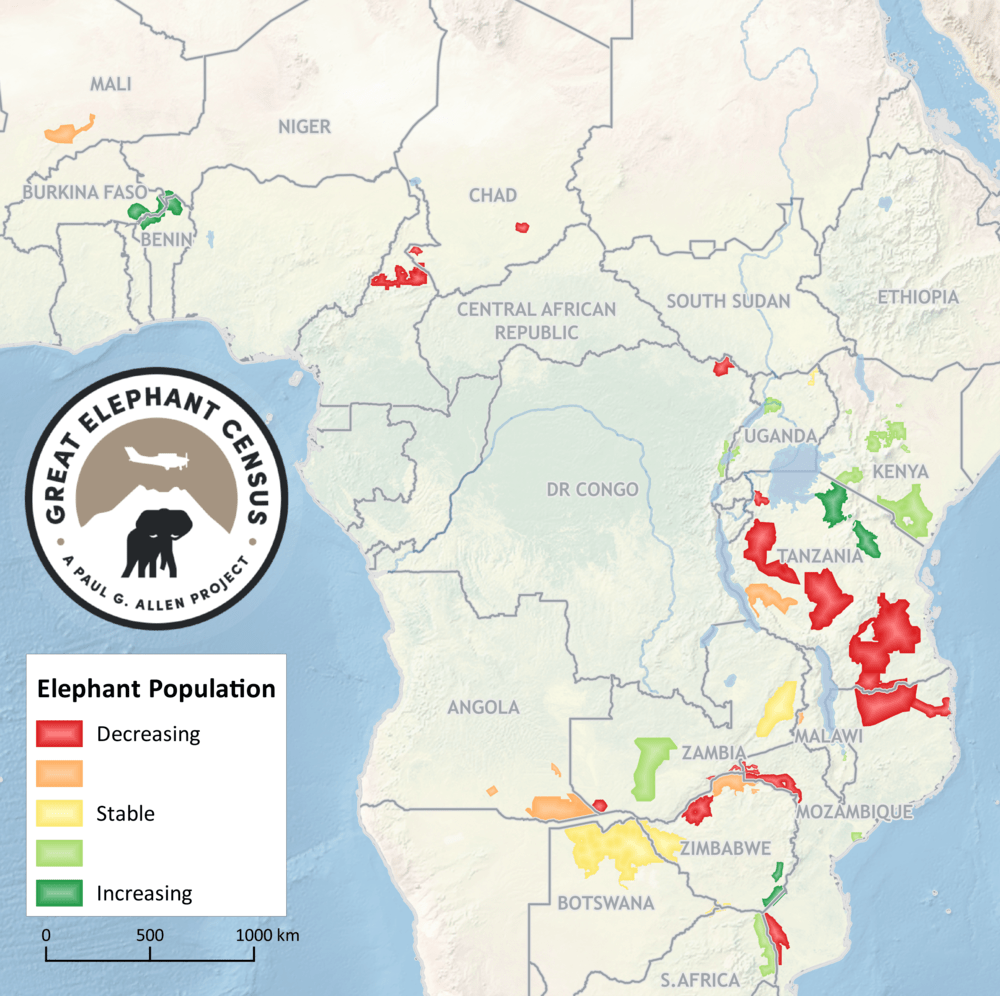Tim, one of the last and largest of the giant tuskers
Watercolor, 22″ x 30″, on Lanaquarelle rough 300 lb, 2021. $22,000
The african elephant (Loxodonta africana)
About Giant Tuskers:
According to the Tsavo Trust, there are only around 20 giant tuskers left in the world today. Giant tuskers, so called because their tusks can reach the ground, are challenged by habitation compression, conflict with local farmers and poachers.
In Kenya, the three most well-known giant tuskers have all recently died. Satao II was killed by poachers, probably with poisoned arrows, two years ago in Tsavo and the Elephant Queen (known as F-MU1 to scientists) died of natural causes earlier last year (also in Tsavo).
- About the reference photo:
David Yarrow, a renown wildlife photographer, who had a long and loving history with Tim, gave me his kind permission t use one of his obituary photos, taken shortly before Tim’s death. David’s photos are characterized by exquisite and stark natural lighting and dramatic angles, and he captured the majesty and a sense of forward momentum in this photo.
Photo of Tim, just weeks before his death by David Yarrow
Elephant Conservation
The African forest elephant is listed as “Critically Endangered” on the IUCN Red List, while the African savanna elephant is listed as “Endangered”.
- Poaching:The illegal ivory trade continues to be a major threat, leading to significant population declines, especially among forest elephants.
- Habitat Loss and Fragmentation:Expanding human populations are encroaching on elephant habitats, leading to reduced space and increased human-elephant conflict.
- Human-Elephant Conflict:As elephants lose habitat and resources, they increasingly enter into conflict with human populations, often resulting in retaliatory killings.
I am item content. Click edit button to change this text. Lorem ipsum dolor sit amet, consectetur adipiscing elit. Ut elit tellus, luctus nec ullamcorper mattis, pulvinar dapibus leo.
About Big Tim
Big Tim was beloved by hundreds of thousands of people worldwide and was a major attraction at Amboseli, his home for 50 years. He was, according to Tsavo gamekeepers “intelligent, mischievous, and good-natured – a genuine gentle giant”.
Tim had survived attacks with spears by farmers during his frequent night raids on crops, was almost drowned in a mud pit, but was saved by Tsavo gamekeepers with help from the Sheldrake Elephant Trust, and was constantly sought by poachers. Despite years of such near-misses, he died of natural causes in March 2020.
Range Map of African Elephants
About the painting:
I started by arranging the David Yarrow image on my laptop in Photoshop, trying out different sizes and colors of the background panel, which, as usual is drawn to golden ration dimensions (1: 1.618). I extended and curled the trunk, but the rest of the image is fairly faithful to David’s photo. The reference photo was black and white but I wanted to capture late afternoon, early sunset golden amber hues to highlight the bumps and ridges that characterize Tim’s features.
I then did a series of small-scale studies to establish palette and make final paper selection.
5″ x 7″ study for “Tim”.

I only used three brushes for the entire painting, my Marie’s #6 pointed round synthetic sable (which comes to such a fine point, and holds so much media, that it is ideal for even hyper-fine details such as the skin pebbling between each wrinkle), and my Loew-Cornell 1″ oval flat, for larger washes. I used a 2″ Princeton synthetic mottler for the background wash, which I was unhappy with as it kept shedding black bristles everywhere!
The palette was limited to Alazarin Crimson, Hansa Yellow, Permanent Orange and Burnt Sienna, with touches of Prussian Blue and Payne’s Grey for depth. The pebbled texture was achieved by liberally sprinkling sea salt over very wet washes of color, then overpainting the resulting texture with fine lines to accentuate pebbling and define larger wrinkles and cracks.
I used Lanaquarelle 300 lb rough, from Legion Paper, after testing 7 different high-end watercolor papers to see which best suited my techniques of large, smooth gradient washes, wet-on-wet, deliberate blooms, seas salt application, multiple layers of glazing and spot lifting.




